Genealogy and The Great Depression
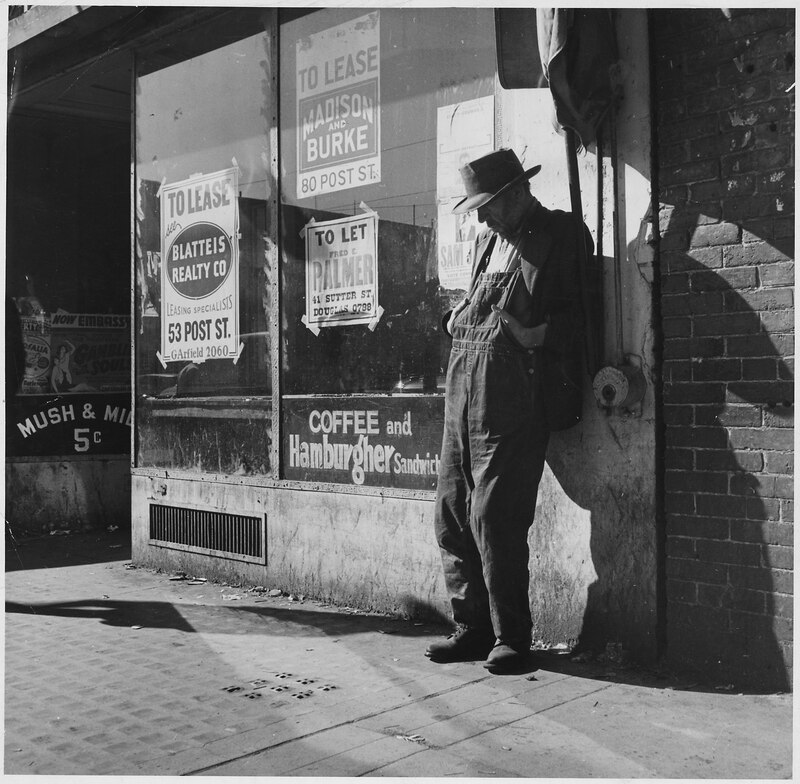
(Credit: U.S. National Archives and Records Administration, Public Domain, https://commons.wikimedia.org/w/index.php?curid=16629774)
Oh, say, don’t you remember, they called me Al
It was Al all the time
Say, don’t you remember, I’m your pal
Buddy, can you spare a dime?
Source: LyricFind – Songwriters: E. Y. Harburg / Jay Gorney – Brother, Can You Spare a Dime? lyrics © Songtrust Ave, Sony/ATV Music Publishing LLC
US government responses to the Great Depression of the 1930s generated some unique resources for genealogists and family historians. Today we’re going to look into some genealogically valuable records generated as a result of President Franklin D. Roosevelt’s New Deal and see how they can be used to enhance family history research.
We need to look for these records for two main reasons. First, the Depression was an all-encompassing event that changed family narratives. Second, how relatives responded to or weathered such a crisis formed an essential aspect of family history. Art was reflecting life when author John Steinbeck used New Deal government records in writing The Grapes of Wrath, specifically narrative reports (mostly 1935–1936) of a California federal migrant labor camp manager.
To demonstrate the value of these resources, we’ll learn what some of them were, the kinds of information they contain, and how to locate, obtain, and use information found in them. We’ll look at the Civilian Conservation Corps (CCC), Federal Emergency Relief Act (FERA), Works Progress Administration (WPA; renamed in 1939 as the Work Projects Administration), and National Youth Administration (NYA). All were New Deal employment programs that generated valuable information for genealogists.
Historical Background
President Roosevelt created emergency relief agencies such as the CCC and WPA to address severe economic problems of the early 1930s. “Our greatest primary task,” he asserted, “is to put people to work.” The CCC and WPA formed to give work to eligible unemployed individuals and alleviate environmental, agricultural, and social problems. They paired those needing work with work needing to be done.
A new question on the 1940 federal census question was asked (column 22) regarding employment of those over fourteen. This was a result of the ongoing depression and agricultural workers experiencing contrary conditions of drought and an oversupply of goods. The question was “Was this person at work for pay or profit in private or non-emergency Government work during week of March 24–30?” If the answer was no, the next question was: “If not, was he at work on, or assigned to, public emergency work (WPA, NYA, CCC, etc.) during week of March 24–30?“ This gave the government the most recent employment information to act on.
The Great Depression and the 1940 Census
All census questions are generated for specific reasons relating to the times in which they are taken. With one out of every four people out of work (a twenty-five percent unemployment rate), the government’s major concern at the 1940 census was dealing with getting people back to work. However, another concern was internal migration due to employment issues, and so the census reflects both of these considerations. The employment and income situations were important enough to dedicate thirteen columns on the census form to document them. Employment questions appear in columns 21-33 (Fig. 1). Because of widespread government projects during this period, there are two categories of work: those at work for pay or profit and those on public emergency work during the week of March 24–30, 1940. This was the last week before the census was taken and gave the nation’s most recent employment information.
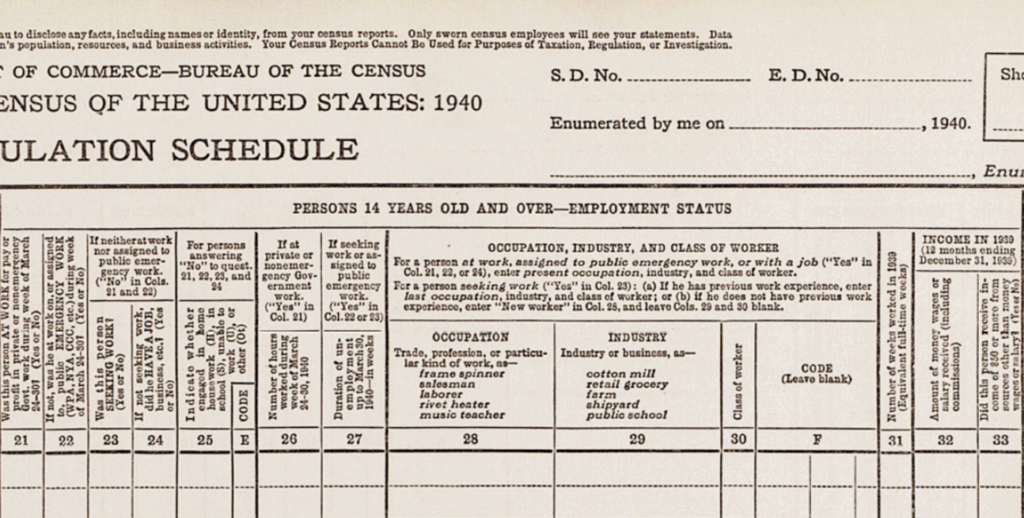
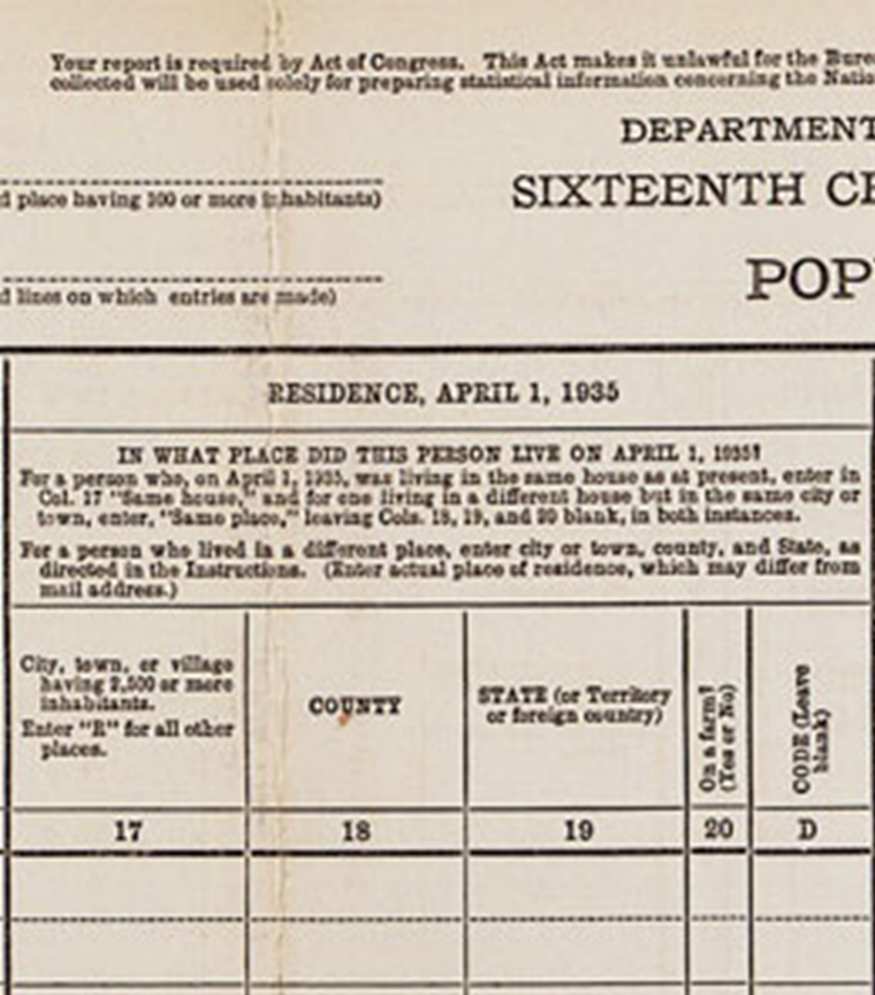
Columns 17-19 (Fig. 2) show government interest in economic characteristics of migrants who may have relocated for employment reasons. If they lived in the same house in 1935, the answer was “same house.” If they lived in the same county in 1935 but in a different place within county, that different place was given. If they lived in a different county in 1935 but in the same state, the different county was given. If they lived in a different state in 1935, the place, county, and state were given. Columns 21-27 (Fig. 3) deal with actual employment. After the completion of the census, the Census Bureau noted that many people on public emergency work could have been misclassified. Columns 28-33 (Fig. 4) deal with the type of occupation, industry, and income during 1939.
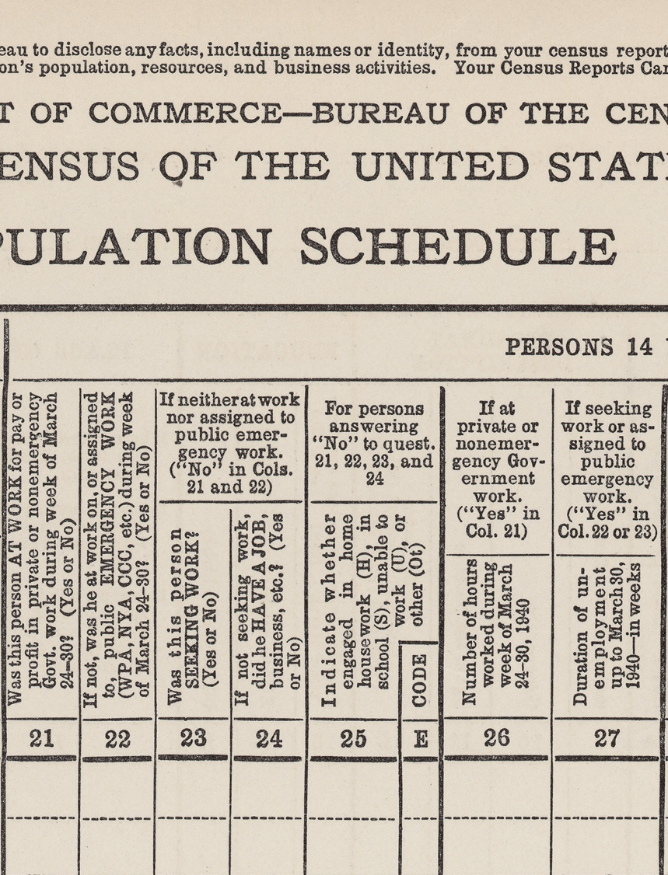
employment.
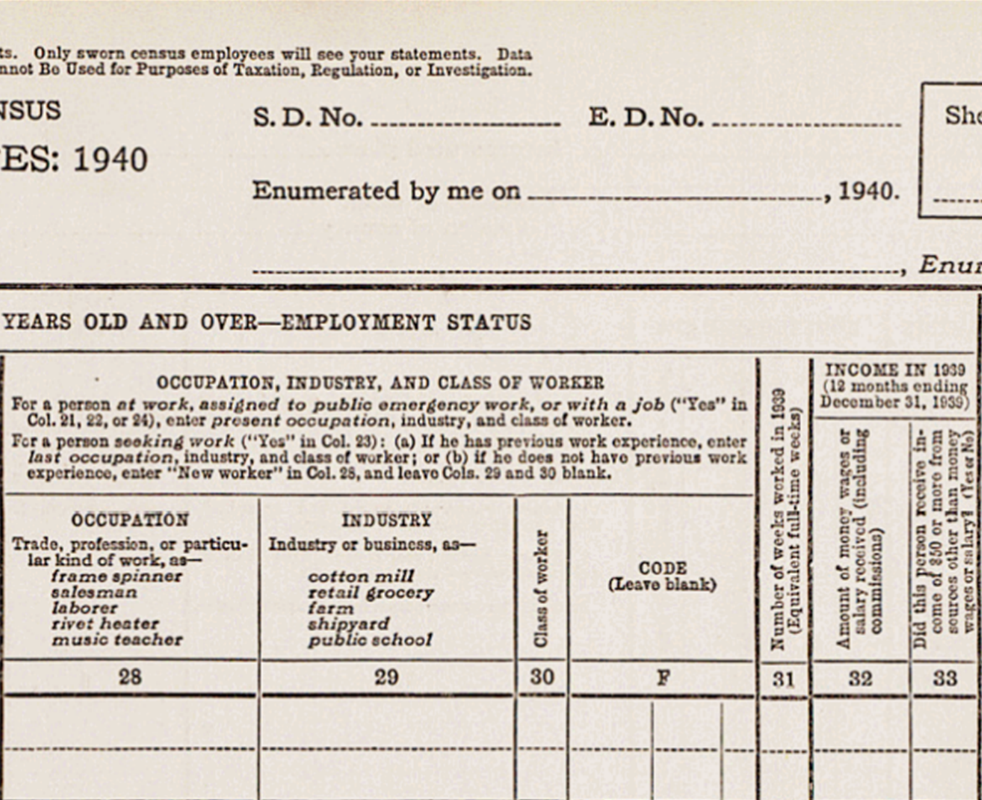
Let’s look at an example. Figs. 5 and 6 tell us that Norike (Kouyoumjian) was a single, 20-year-old unemployed printer looking for work. He lived in the same family house in Waltham, Massachusetts in 1940 that he lived in in 1935. He completed 12 years of education and had worked for 41 weeks in 1939 , earning $380 dollars that year. In column 30 (“Worker Class”), the letters “PW” indicates that he was working for a wage.
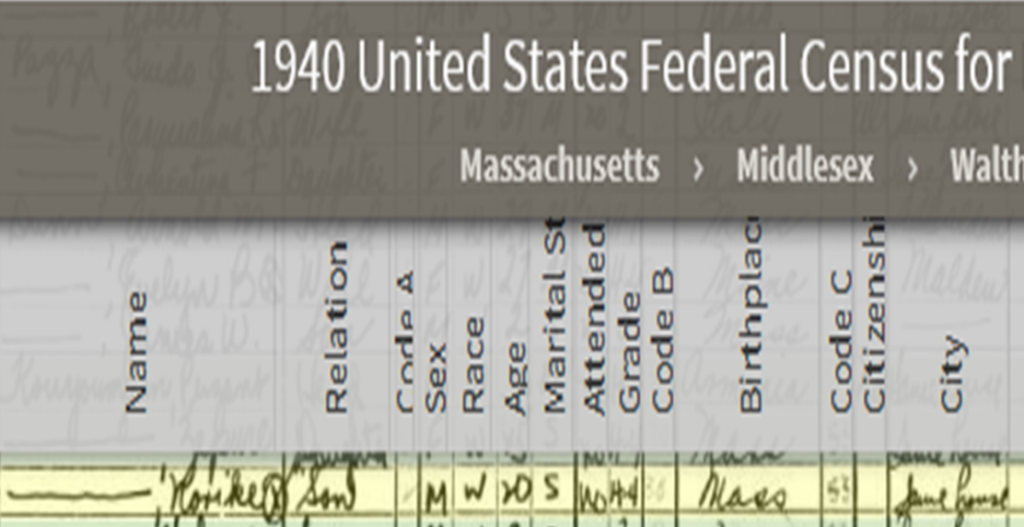

Having examined the types of census questions asked by the federal government after ten years of nationwide economic hardship, let’s focus on some of the major government programs that sought to ease the burdens of millions of its unemployed citizens.
Civilian Conservation Corps
The CCC was enacted by Executive Order 6101, “An act for the relief of unemployment through the performance of useful public work, and for other purposes.“ It was a public work relief program that operated from 1933-1942 for unemployed, unmarried men. Though originally intended for young men ages 18–25, it was eventually expanded to ages 17–28. It was a major part of President Roosevelt’s New Deal that provided 150 types of work, unskilled manual labor jobs related to conservation and development of natural resources in rural lands owned by federal, state, and local governments. Over its nine-year existence three million young men participated and were provided with shelter, clothing, and food, together with a wage of $30 (about $570 in 2017) per month ($25 of which had to be sent home to their families). For more information, including how to request copies of records of those who served, visit the Civilian Conservation Corps Legacy web site.
In the following example of a CCC employment record, we get general information in Part I such as the person’s name, address, birth date, birth place, name and relationship of nearest relative, level of education, and occupational qualifications. We also learn that he had served in the CCC prior to applying in 1940 (Fig. 5). In Part II, Norike signed his name to an oath of enrollment, indicating he would serve for six months and obey all CCC rules and regulations (Fig. 6). Part IV provides a record of his service (Fig. 7).
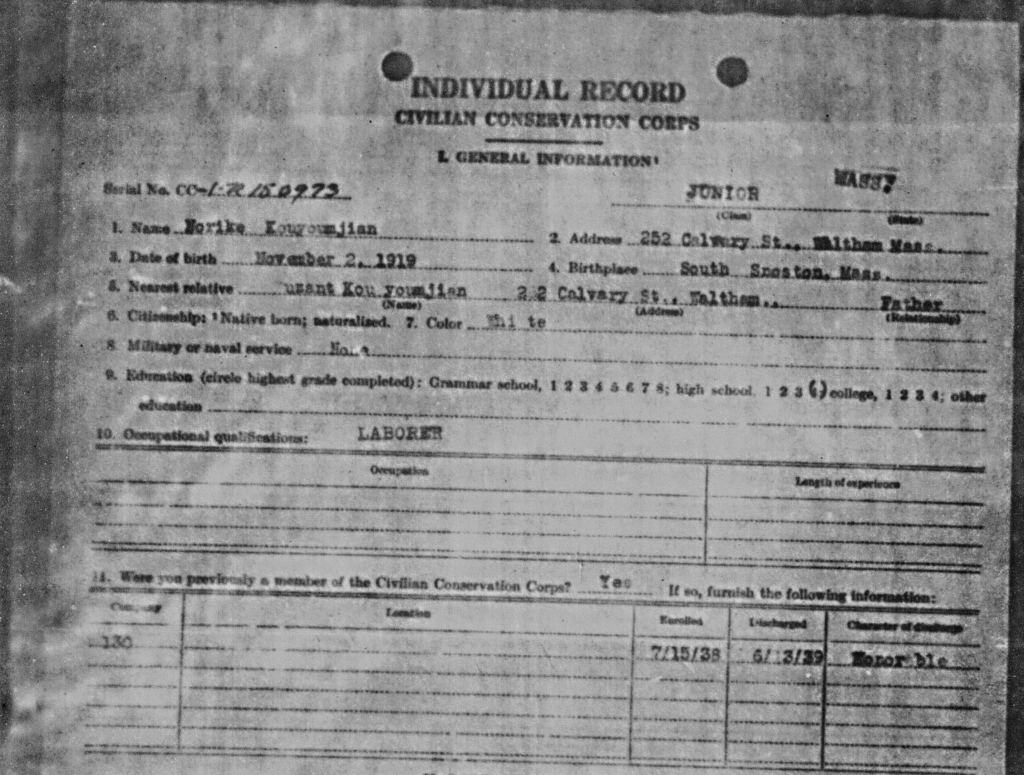
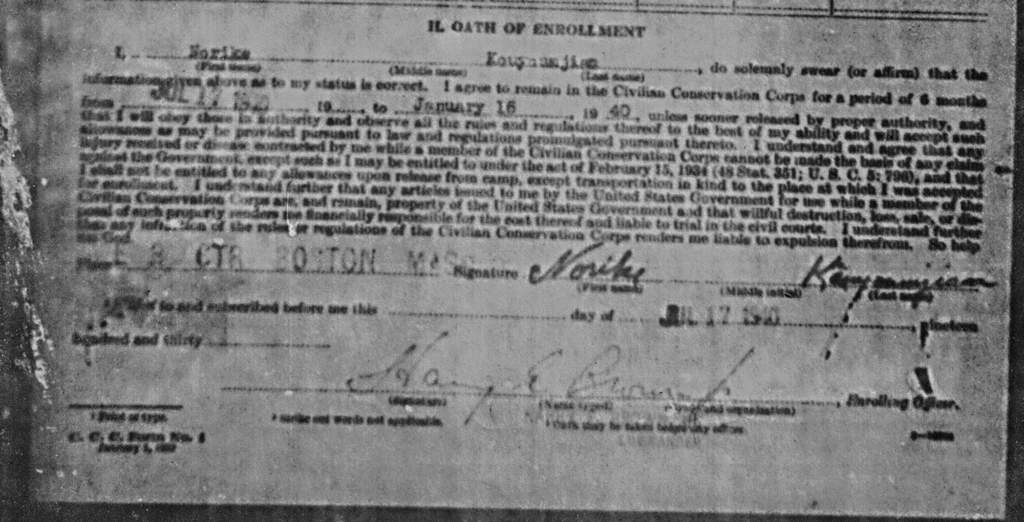
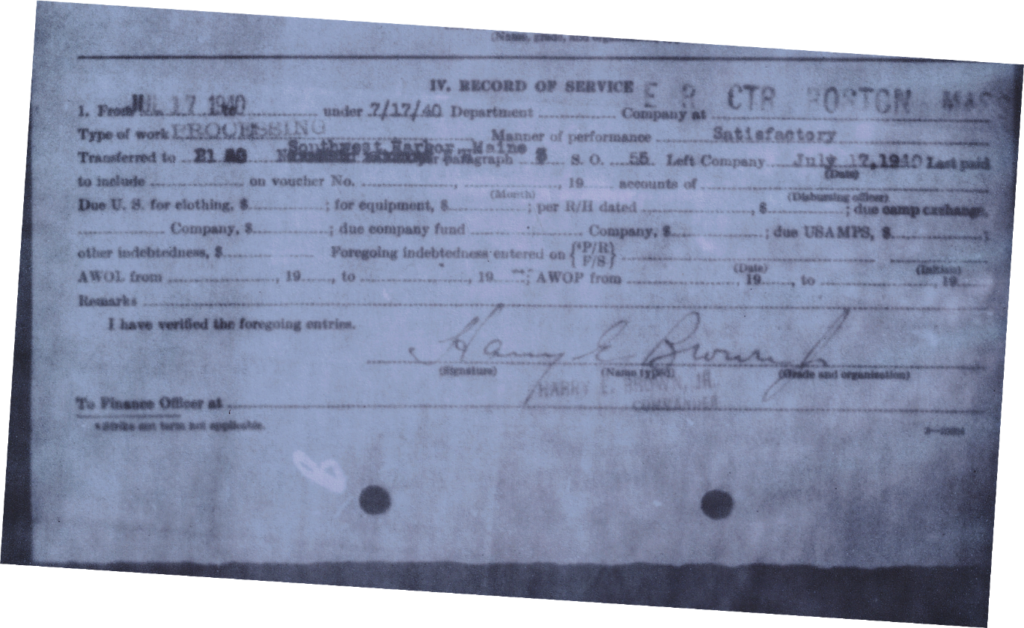
CCC Accident Reports
Besides enrollment and service records, the CCC also maintained records pertaining to accidents that you can find in the National Archives catalog. One group is “Official Reports of Injury, 1937-1940,” but includes only the surnames Mahler through Zyskowski, You can find this group here. The other is “Reports of Accidents and Injuries, 1933-1942.” The latter is kept in three-year-span segments, and only the surnames A through Carter appear in the segment covering 1933-1936. You can find this group in the catalog here. Files are arranged alphabetically and vary in size. They can include witness statements, affidavits, death certificates, copies of service records, and other documents containing information on enrollees. The only images in the catalog are those used in NARA’s Prologue article on these reports.
Finding CCC Accident Reports
There are approximately 7,600 accident reports among these two records series.National Archives staff created a file list for all of these records, which are housed only in textual format at National Archives in College Park, Maryland. They provide an amazing picture of a person’s life, and it is well worth doing a search. If you get a positive result for your name search, record the ARC identifier number in the catalog (located under the person’s name) to order file copies.
This is the cover sheet of the file of Oliver B. Roaden, who accidentally drowned in Rockcastle River, London, Kentucky, on April 11, 1941. The file contains 72 pages and includes the investigation and results, photos of parts of the river, witness statements during inquiry, the death certificate, and safety recommendations.
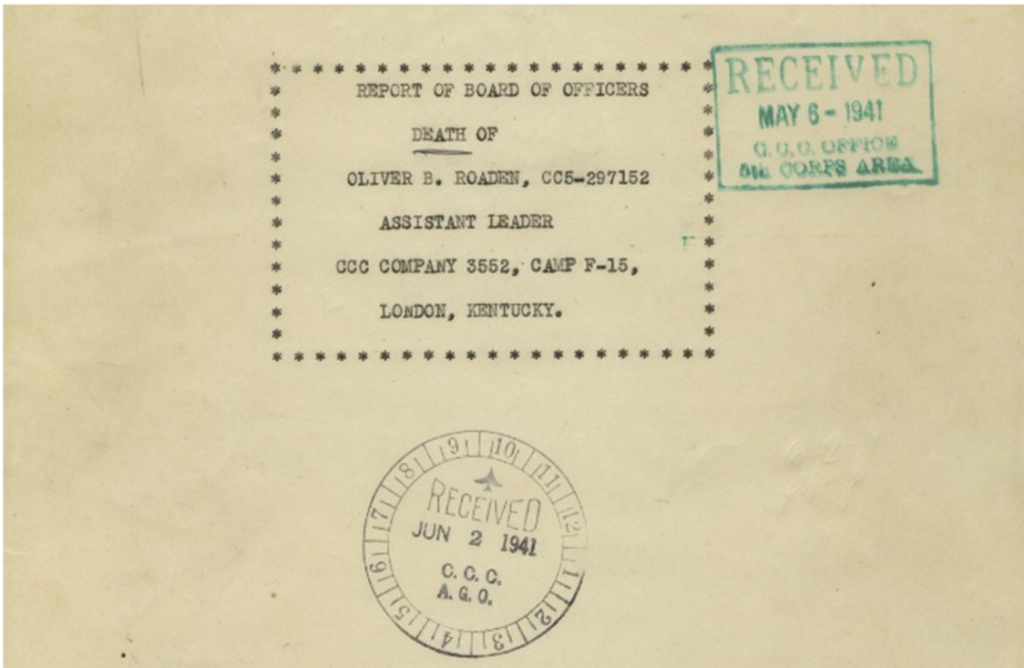
There was also the Indian Civilian Conservation Corps that employed thousands of Native Americans and brought material aid and conservation efforts to their considerable land resources. Peculiarities of these records can complicate research because they were administered at the tribal level, and personnel records never consolidated nationwide. Whatever was saved is available piecemeal only in records of various Bureau of Indian Affairs agencies. You need to know the enrollee’s tribal affiliation or reservation where work took place before embarking on any research.
Federal Emergency Relief Act (FERA)
On May 12, 1933, President Roosevelt’s Federal Emergency Relief Administration, a grant-making agency authorized to distribute federal aid to the states for relief, was established. It was built on President Herbert Hoover’s Emergency Relief and Construction Act. FERA was replaced in 1935 by the WPA. By the end of December 1935, FERA had distributed over $3.1 billion and employed more than 20 million people. Its correspondence files are full of valuable genealogical information and Depression-era experiences that will enrich family histories. Some of these include “Appeals and Applications for Employment,” “Rural Rehabilitation,” and “Repatriation of Aliens.” There are also files dealing with homeless or transient WW I veterans, such as that of Edward Peagler. This is his Form 600 – Certification of Eligibility for employment (Fig. 8) is part of the Veterans’ Applications for Employment on Work Projects.
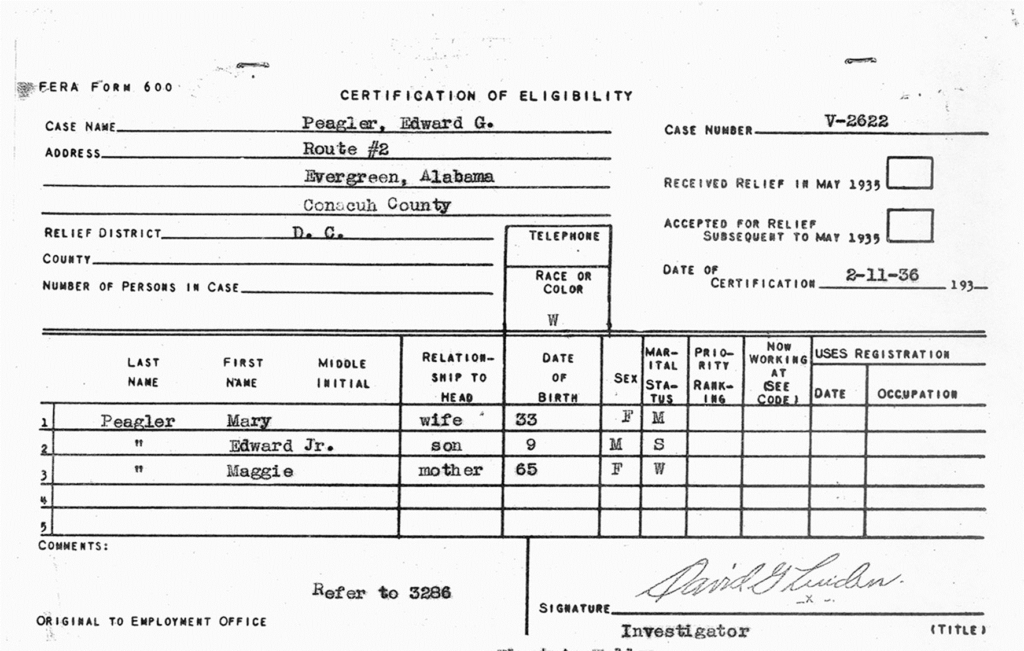
Works Progress Administration/Work Projects Administration
The WPA replaced FERA on May 6, 1935 and was renamed the Work Projects Administration in 1939. It shifted the focus of economic recovery from direct relief assistance to enhanced work relief, and provided jobs to about 8.5 million unemployed workers on public projects sponsored by federal, state, or local agencies, and on defense and war-related projects. The WPA also included unemployed youth through its National Youth Administration (NYA) projects. It was abolished by Presidential letter on December 4, 1942, effective June 30, 1943.
The WPA’s most significant program was Federal Project Number One or Federal One, a collective name for a group of projects under its supervision. These included the Federal Art Project, Federal Music Project, Federal Theatre Project, and Federal Writers’ Project. In its prime, the WPA employed up to 40,000 writers, musicians, artists, and actors because, as Secretary of Commerce Harry Hopkins put it, “Hell, they’ve got to eat, too.”
Federal Art Project
At the height of its existence the Federal Art Project employed over 5,300 artists in several divisions. The Arts Service Division created illustrations and posters for WPA writers, musicians, and theaters. The Exhibition Division had public exhibitions of artwork from the WPA. Artists from Art Teaching Division worked in settlement houses and community centers to give classes to about 50,000 children and adults. The Project set up over 100 art centers around the US that served an estimated eight million individuals.
Federal Music Project
Over 16,000 musicians were employed by the Federal Music Project. It was intended to create several different ensembles such as orchestras, opera units, choral units, chamber groups, dance, concert, and military bands, and theater orchestras (Fig. 9). These ensembles gave about 131,000 performances and programs to 92 million people each week. They performed dances, plays and radio dramas. They also taught weekly music classes to about 132,000 children and adults. To make music more widely available, they also recorded folk music, worked as copyists, arrangers, and librarians, and even experimented with music therapy.

Federal Theatre Project
The Federal Theatre Project was a relief measure to get writers, artists, theater workers, and directors back to work,. About 12,700 performers presented over 1,000 performances monthly to almost one million people. The Project produced 1,200 plays in the four years of its existence, and introduced 100 new playwrights such as Arthur Miller, Orson Welles, John Houseman, and Elia Kazan. It ended after funding was cut because of strong Congressional objections to its left-wing political tone in less than ten percent of productions.
Federal Writers’ Project
The Federal Writers’ Project employed 6,686 writers at its peak in 1936 to utilize skills of unemployed white-collar workers. Its best known product was the American Guide Series, a run of detailed guidebooks for every state that include descriptions of towns, waterways, historic sites, oral histories, photographs, and artwork (Fig. 10). The catalogue of WPA Writers’ Program publications was published in September 1941 and is available in the HathiTrust Digital Library. Another well-known project was the Slave Narratives and folklore collections. Project writers also performed research and editorial services to other government agencies.
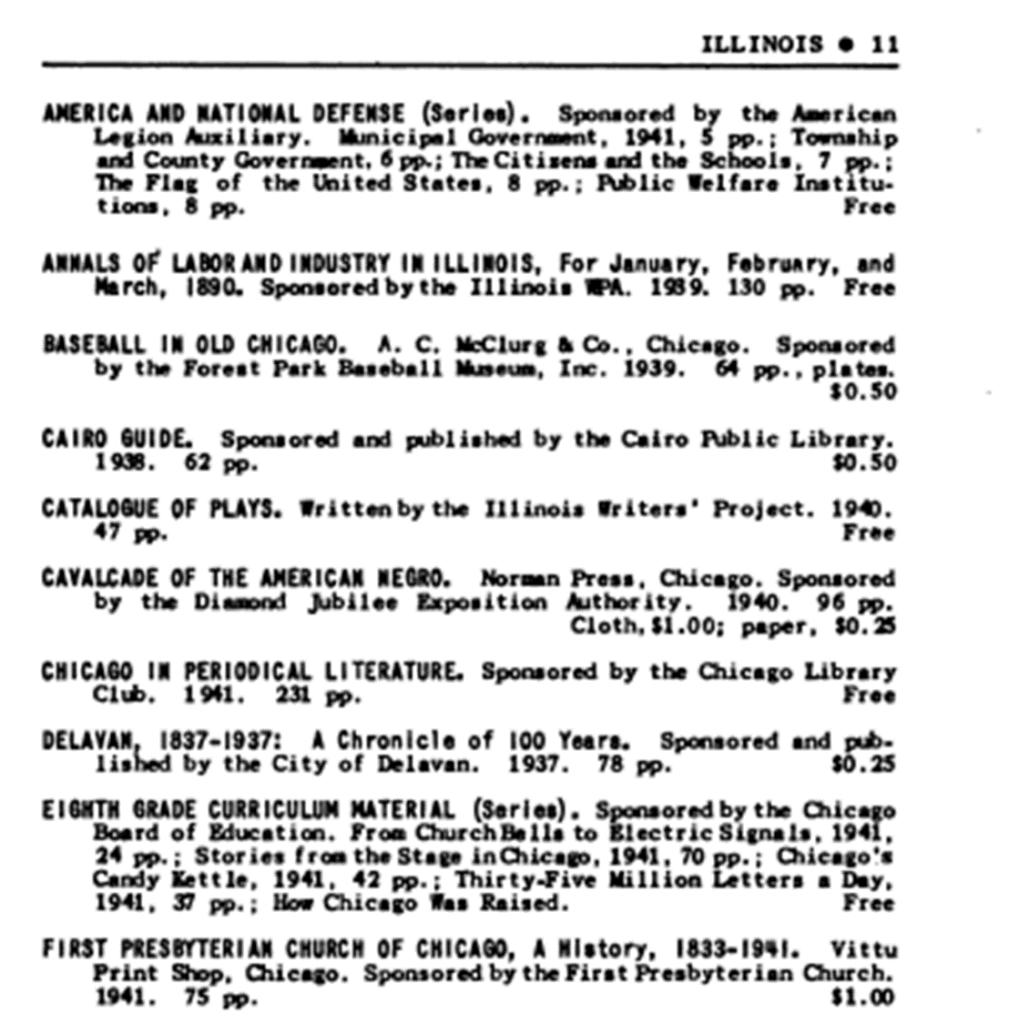
American State Guide series.
Historical Records Survey
The Historical Records Survey was the smallest project of Federal Project Number One. It was tasked with identifying, collected, and conserving US historical records and was one of the largest bibliographic efforts. At its peak it employed over 4,400 workers. Its biggest task was located, identify, arrange, and describe massive amounts of public records in county archives all over the country, known as the Survey of County Records (Figs 11-12). This resulted in publication of 628 volumes of county inventories. Works also surveyed federal archives, church records, and American imprints. They can be found online on Google Books, the Internet Archive the HathiTrust Digital Library, and other digital collections.
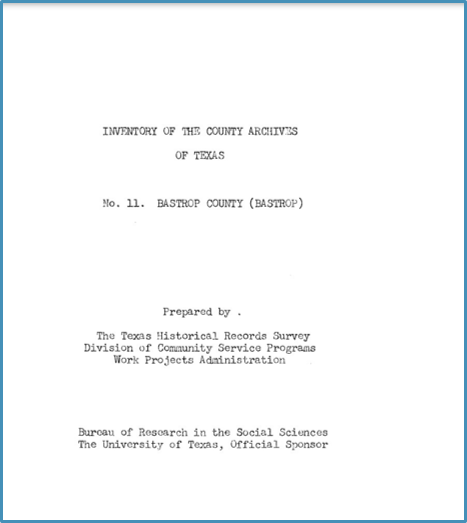
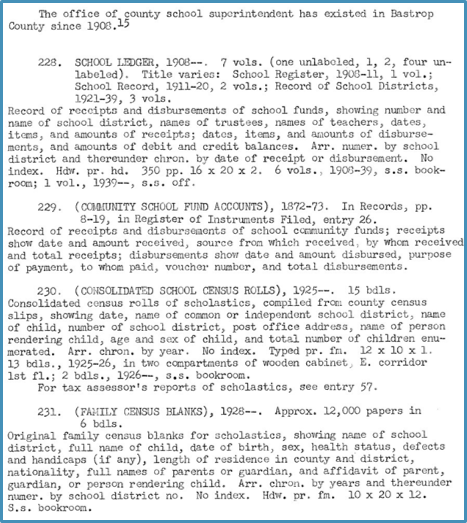
No. 11, Bastrop Co., Texas
Central Correspondence Files of the WPA and Its Predecessors
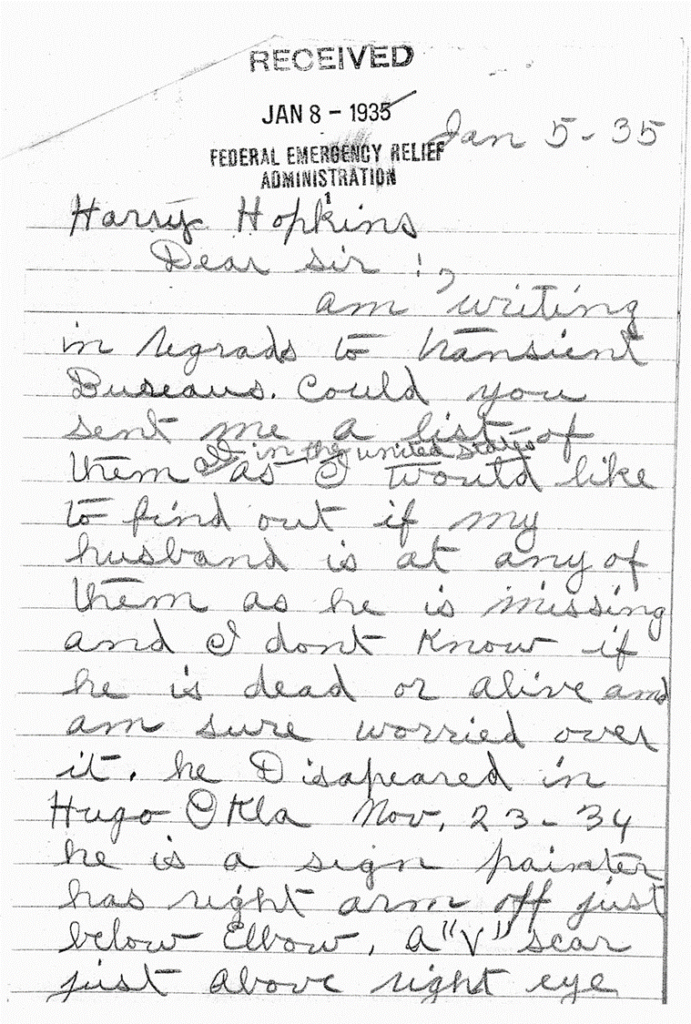
This record group at the National Archives in College Park, Maryland is not on-line but contains a wealth of FERA and WPA correspondence documenting personal experiences of the Great Depression, from farmers, US citizens stranded abroad, transient WW I veterans, and people seeking employment on work projects. These files often contained personal information, and many were personal pleas for financial assistance to President and Mrs. Roosevelt. They described economic circumstances of destitute families. Mrs. S. A. Dailey of Ardmore, Oklahoma directly asked Secretary of Commerce Harry Hopkins for a list of registrants at local transient bureaus across the US, “as I would like to find out if my husband is at any of them as he is missing [since November 1934] and I don’t know if he is dead or alive and am sure worried about it.” Mrs. Dailey even provided a physical description, as if Hopkins needed to know (Fig. 13).
National Youth Administration
The National Youth Administration (NYA) was established in 1935 as government’s answer to “restless youths” aged 16-25. It provided part-time jobs to high school and college students who could earn money to continue their education. Dropouts performed community-related activities and public service projects. Unlike the CCC, records weren’t kept of all youth participating in this program, but some still exist, such as Filled-In Questionnaires from College Students Receiving Aid, and Related Correspondence, May and June 1936; Copies of Letters Received from NYA Youth and Their Parents, 1942-43; Correspondence of the Director with Applicants for Employment in the Camps, 1936-1937; Miscellaneous File of Case Histories Mainly “Success Stories” and Endorsements of the NYA by Beneficiaries of its Services, 1937-1942. However, these are fairly small collections; some records may be found on microfilm with WPA records.
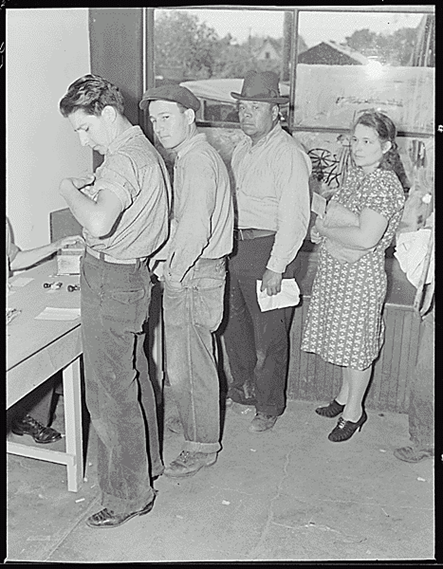
Requesting Records
To get copies of personnel records related to CCC, WPA, or NYA projects, you should send a written request to the National Archives at St. Louis, Attn: Archival Programs, POB 38757, St. Louis, MO 63138, or send an email to [email protected]. Include your full name and the birth date of the requested individual. If the person worked for the WPA, include the city and state of employment. For medical or fatality forms for a CCC enrollee, include this information with your request. If record is located, the Archives will send an invoice for it. Since many people have similar names, provide as much information as possible (for example: birthplace, parents’ names, and years of employment).
Copy fees are $20.00 for a record under five pages and $60.00 for a record six pages or more. Be aware that CCC and WPA records are on microfilm, and copies of these records are sometimes difficult to read. Also, some personal information is redacted in accordance with the personal privacy exemption of the Freedom of Information Act (5 U.S.C. 552 (b) (6)).
It’s a good idea to keep one’s perspective while working with WPA and other records generated by Americans during the Great Depression, according to professional genealogist Loretto Dennis Szucs, who wrote: “The U.S. investment in the WPA of the 1930s and 1940s continues to pay rich dividends to family historians—and more directly to the individuals and families who were able to keep body and soul together because of the work the agency provided.”
Did your ancestors or other relatives find work in a New Deal project? NOW is the time to find out.




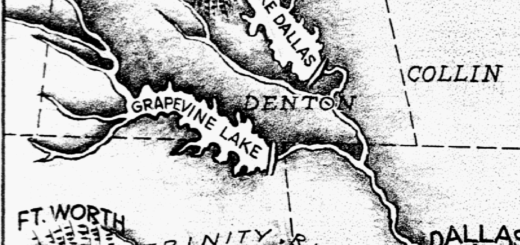
Recent Comments